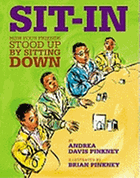
 This deceptively simple picture book from the husband-and-wife team behind Duke Ellington: The Piano Prince and His Orchestra explores the idea of peaceful protest that brings results. What began as a silent statement by four African-American college students at a segregated Woolworth's lunch counter in Greensboro, N.C., on February 1, 1960, blossomed into a "sit-in" that spread to four more states in the South. Andrea Davis Pinkney crafts a text as spare as poetry and circles back to a refrain as simple and clear as the four friends' request: "They didn't need menus. Their order was simple. A doughnut and coffee with cream on the side." But no one will take their order because of the color of their skin. Brian Pinkney portrays the four friends in jackets and button-down shirts; two wear ties. David, Joseph, Franklin and Ezell sit silently while everyone else gets served. An African-American waitress keeps her back to the four young men as she serves a half-dozen white people at the other end of the drugstore counter.
This deceptively simple picture book from the husband-and-wife team behind Duke Ellington: The Piano Prince and His Orchestra explores the idea of peaceful protest that brings results. What began as a silent statement by four African-American college students at a segregated Woolworth's lunch counter in Greensboro, N.C., on February 1, 1960, blossomed into a "sit-in" that spread to four more states in the South. Andrea Davis Pinkney crafts a text as spare as poetry and circles back to a refrain as simple and clear as the four friends' request: "They didn't need menus. Their order was simple. A doughnut and coffee with cream on the side." But no one will take their order because of the color of their skin. Brian Pinkney portrays the four friends in jackets and button-down shirts; two wear ties. David, Joseph, Franklin and Ezell sit silently while everyone else gets served. An African-American waitress keeps her back to the four young men as she serves a half-dozen white people at the other end of the drugstore counter.
Even though the four African-American students' serene faces and calm seated positions recall a meditative pose, the ink outlines and watercolor wash in rosy tones swirl with movement. Their portraits communicate the energy at the root of their stillness. "They sat straight and proud. And waited. And wanted. A doughnut and coffee, with cream on the side." A policeman comes in, holding a billy club, but lets them be ("No crime in sitting. No harm in being quiet. No danger in looking hungry"). So the "Woolworth's man" closes the store, and the four go home to dinner, "where they are served first." As the author describes other students, both black and white, joining the sit-ins across the South, the artist extends the lunch counter, which serpentines across an entire spread. A backlash develops in response to the movement's success, and Brian Pinkney represents the opponents' anger as a purple tempest of finger pointing and angry expressions muted by the peaceful faces of the protestors in the foreground. Pull quotes from Dr. Martin Luther King Jr., a timeline of milestones in the civil rights movement and an author's note clearly demonstrate for young readers the injustice that prompted the sit-ins and their context within the civil rights movement. On this 40th anniversary of the Greensboro sit-ins, this book is a powerful and eloquent reminder of the role of young people as the instrument of change and the impact they can continue to have on society at large.--Jennifer M. Brown

